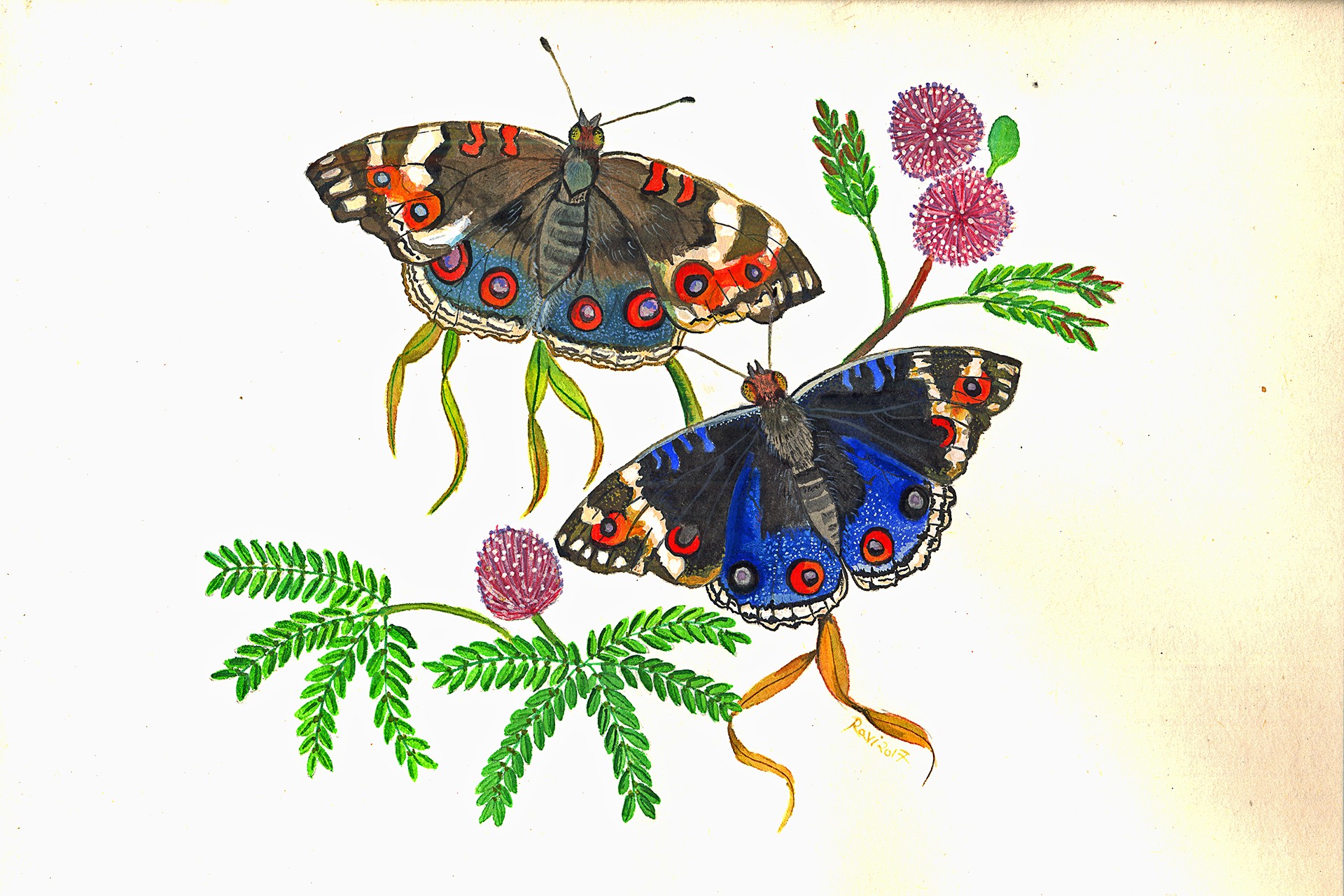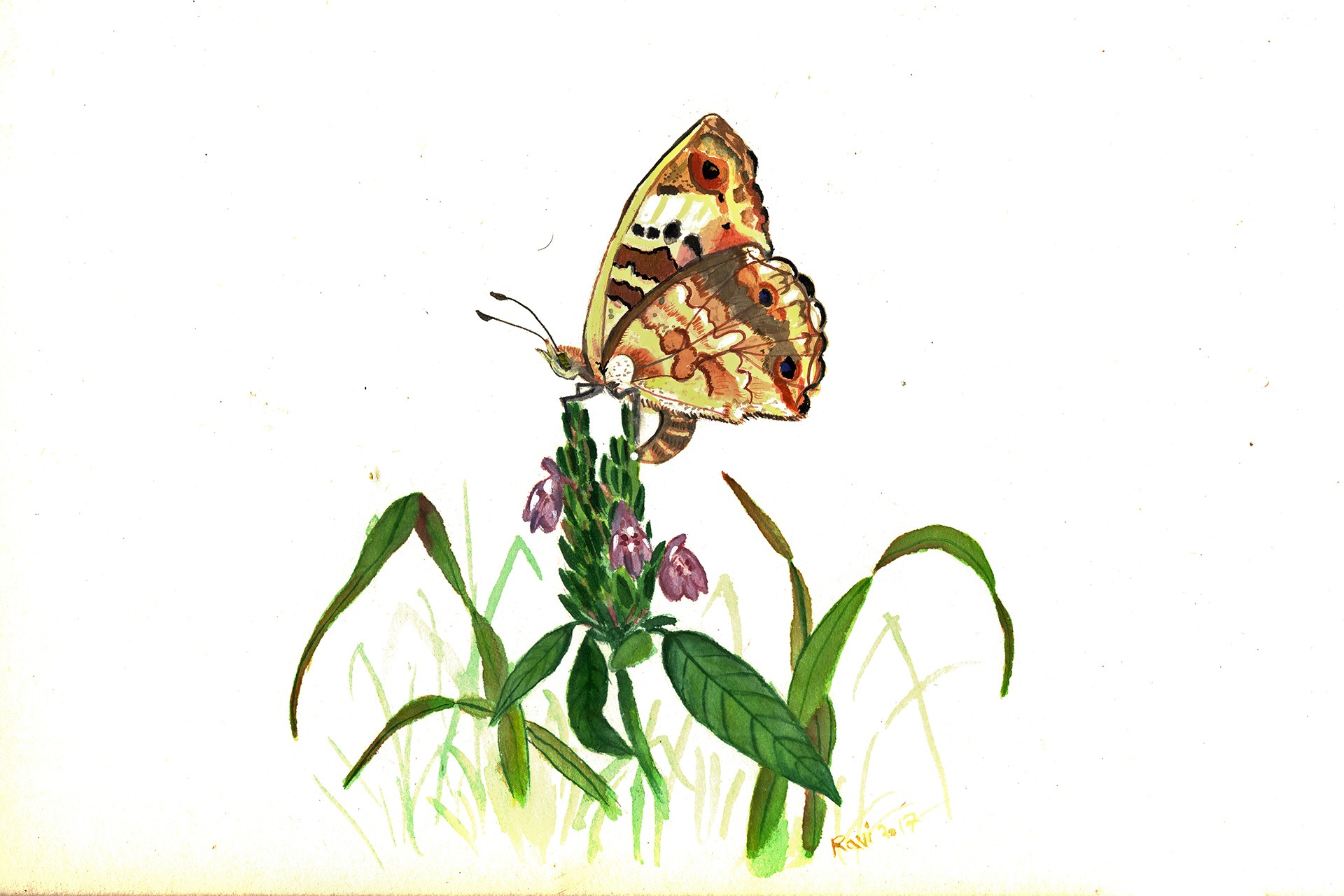Sure, there’s a wealth of flora and fauna to seek out in our sanctuaries, reserves and jungles. Wildlife enthusiasts will always be drawn to, well, wild spaces, but in the quiet time between each adventure, we should remember there’s a wide range of fascinating biodiversity to encounter in our cities, too. Through this new series, we encourage the Nature inFocus community to explore our urban biodiversity, to notice the often-overlooked creatures in our midst, and to appreciate their fascinating ecology and behaviour. Each story will focus on a single species representing different taxa, and will be illustrated by a different artist. This is the third story in the series. Look out for the next installment, all about the Golden Shower Tree (Cassia fistula) next month.
Contrasts add beauty and complexity to the natural world. A butterfly sporting an eye-catching electric blue on one surface of its wings and an inconspicuous brown on the other, may well baffle you. Chances are, it’s a striking male Blue Pansy (Junonia orithya) butterfly that has caught your eye.
In J. orithya males, wing pairs, when opened (wing-upperside), display velvety black fore-wings and shiny blue hind-wings. Females, on the other hand, are of a dusky dull-brown shade and larger than their male counterparts. Both have wings ornamented with distinctly arranged, attention-grabbing ‘eyespots’. In contrast, when their wings are folded (to reveal the wing-underside), both sexes appear dull brown, with relatively less pronounced eyespots and wavy patterns on their wings.
The adults may display slightly different colouration, depending on the season during which they are observed, especially on the wing-underside. In dry season morphs, the underside is duller and eyespots are even less conspicuous as compared to the wet season morphs. The wing-upperside remains more or less similar in both. These morphs, particularly the dry season ones, are best adapted to be camouflaged against their resting background, such as the dead, fallen leaves of the dry season, so they can better ward off predatory attacks.
This species has a widespread occurrence, ranging across Africa, south and southeast Asia, and Australia. The Blue Pansy happens to be one of the 50 most commonly encountered butterfly species in the metro cities of India. It loves the sun and open areas, including your neighbouring parks and gardens. In grassy patches, it actively scouts for nectar plants through warmer parts of the day.
The male butterflies display territorial behaviour and can be observed chasing away other males that try to intrude. It is hypothesised that individuals do this to defend the best nectar reserves (which adults feed on) and/or host plants (which caterpillars eat), possibly increasing their chances to attract mates.
Its host plants include commonly occurring species like Mimosa pudica (Touch-me-not), Sida rhombifolia (Arrowleaf Sida) and Justicia procumbens (Water Willow). Females lay oval-shaped, green-coloured eggs on young shoots or leaves of these host plants. The eggs are extremely tiny, ranging from 0.6-0.7mm in diameter, and are visible only on close observation. They take 2-3 days to hatch and the emerging caterpillars use the egg shell as their first meal, before moving on to consuming leaf tissues. It takes 25-30 days for the young caterpillar to transform into an adult butterfly.
As adults, their wings, like all butterflies, will be covered by thousands of chitinous scales. The structure and arrangement of these scales determine the colour and patterns we see, be they eyespots or wing bands. It is thought that the evolution of the wing colour-patterns in some Junonia species occurs in response to environmental stress, like changes in temperature. Some lab experiments that subject Blue Pansy pupae to low temperatures i.e. cold shock at an early stage, find that the emerging adults show broader wavy patterns (near the wing-upperside margins) and these shift closer to eyespots.
These eyespots, a distinctive feature on the wings of many moths and butterflies, are not just ornamental either. Butterfly wing colour patterns are known to have ecological functions. The eyespots contribute greatly towards the Blue Pansy’s survival. In defence against predators, they play a role by employing one or two key strategies: intimidation and/or deflection.
Put simply, the intimidation hypothesis holds that the larger, more conspicuous eyespots serve to frighten and/or fool the attacking enemy by their striking appearance, or by their resemblance to the eyes of the predators themselves (such as birds); or both. These warning signals may lead to a delay or a complete aborting of the attack, thus increasing the chances of the butterfly’s survival.
The deflection hypothesis explains the significance of peripherally located eyespots. It is thought that the smaller eyespots, located close to the wing margins, catch the attention of predators. On noticing them, the predator launches an attack at a point away from the more vital parts of the body (the head, thorax and abdomen), possibly allowing the butterfly to escape.
Based on their eyespot size and arrangement, the Blue Pansy is predicted to draw on the intimidation strategy.
Spotting the Blue Pansy adorned with eyespots is really a visual treat. They can be identified easily when settled on the ground to bask. They lay their wings flat, displaying the conspicuous side. The next time you see one basking, or flitting around grassy havens, we hope you will be charmed by its beauty and antics, as well as by its remarkable adaptations.
Last month, we wrote about Tortoise Beetles. Read the story here.


